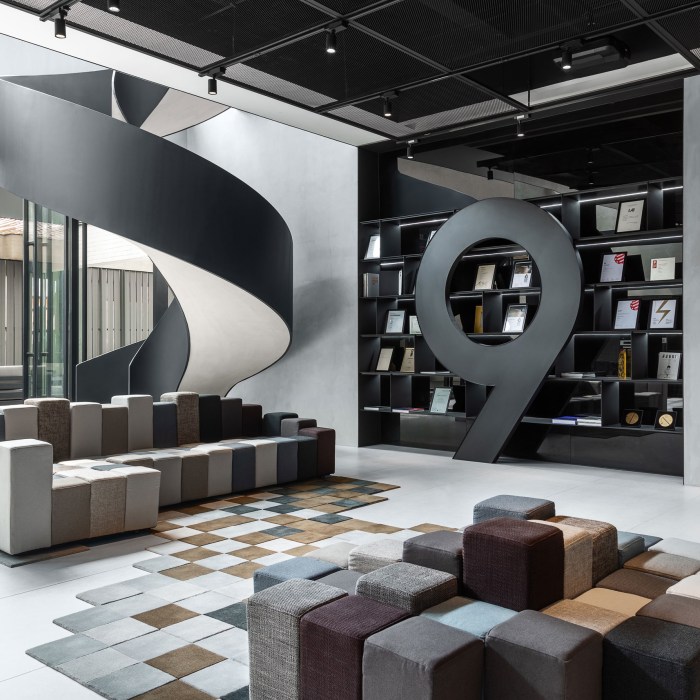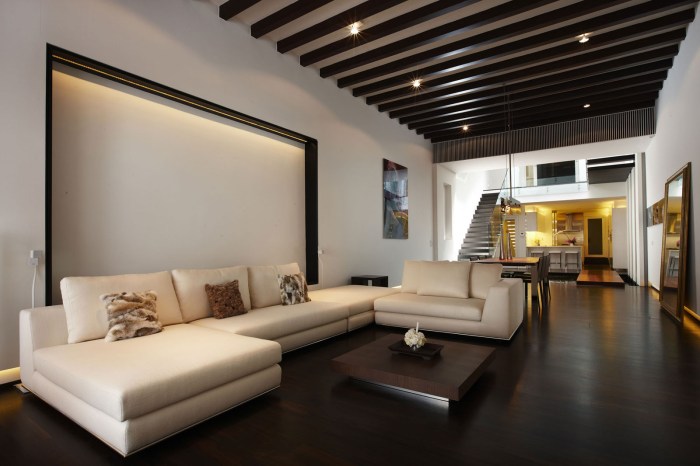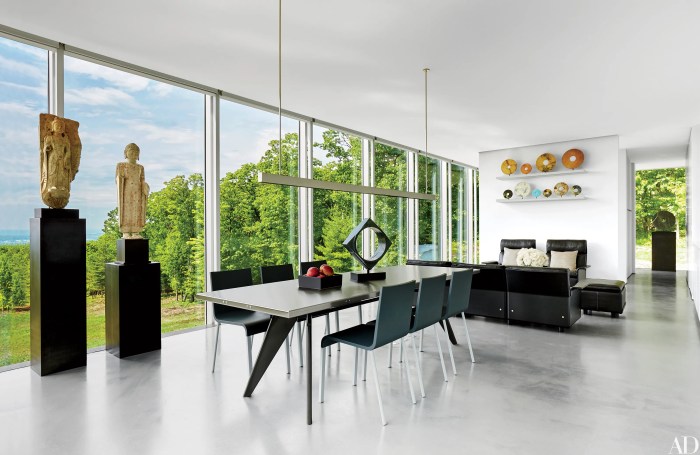Exploring the World of Interior Architecture

Embark on a journey through the realm of interior architecture, where creativity meets functionality to transform indoor spaces into captivating works of art.
Delve into the intricate details of spatial layout, materials, and design principles that shape our living environments.
Definition of Interior Architecture

Interior architecture involves the design and coordination of interior spaces to create functional, aesthetically pleasing environments. It goes beyond just decorating a room and focuses on the structural aspects of a space, such as layout, materials, lighting, and acoustics.Interior design and architecture are closely related disciplines, with interior architecture falling somewhere between the two.
While interior design focuses on the aesthetics and decor of a space, interior architecture considers the overall structure and functionality of the interior environment. Interior architects work with architects and designers to ensure that the interior spaces meet the needs and requirements of the users while complementing the overall architectural design.The role of an interior architect is crucial in shaping indoor spaces that are not only visually appealing but also practical and efficient.
They must consider factors such as traffic flow, spatial organization, and the integration of building systems to create cohesive and functional interiors that enhance the overall user experience.
Elements of Interior Architecture
Interior architecture encompasses various key elements that contribute to creating functional and aesthetically pleasing spaces. These elements include spatial layout, materials, lighting, furniture, color schemes, textures, and sustainability principles.
Spatial Layout
The spatial layout of a space is crucial in interior architecture as it determines how people move within the space and interact with it. It involves the arrangement of walls, doors, windows, and circulation paths to optimize functionality and efficiency.
Materials
Materials play a significant role in interior architecture, influencing the overall look and feel of a space. From flooring to wall finishes, the selection of materials such as wood, stone, glass, metal, and textiles can enhance the design aesthetic and functionality of a space.
Lighting
Lighting is a key element in interior architecture as it affects the mood, ambiance, and functionality of a space. Natural and artificial lighting sources are strategically used to highlight architectural features, create focal points, and establish the desired atmosphere.
Furniture
Furniture selection is essential in interior architecture to provide comfort, functionality, and style. The choice of furniture pieces such as seating, tables, storage units, and accessories should complement the overall design concept and enhance the user experience.
Color Schemes and Textures
Color schemes and textures play a vital role in interior architecture by adding depth, visual interest, and character to a space. The careful selection of colors and textures can influence the perception of space, evoke emotions, and create a cohesive design scheme.
Sustainability
Sustainability is increasingly important in interior architectural design, with a focus on using environmentally friendly materials, energy-efficient systems, and sustainable practices. Designing with sustainability in mind helps reduce environmental impact and promote healthier living environments.
Design Principles in Interior Architecture

Interior architecture relies on various design principles to create functional and aesthetically pleasing spaces. These principles include balance, harmony, rhythm, emphasis, and proportion, which play a crucial role in shaping the overall look and feel of a space.
Balance
Balance in interior architecture refers to the distribution of visual weight in a room. It can be achieved through symmetrical or asymmetrical arrangements of elements such as furniture, lighting, and accessories. For example, a room with a large, heavy sofa on one side can be balanced with a grouping of smaller chairs or a visually striking piece of artwork on the opposite side.
Harmony
Harmony involves creating a sense of cohesion and unity in a space by using elements that complement each other. This can be achieved through color schemes, materials, and textures that work together to create a harmonious environment. For instance, using a consistent color palette throughout a room can help create a sense of harmony and flow.
Rhythm
Rhythm in interior architecture refers to the visual flow and movement within a space. This can be achieved through the repetition of colors, shapes, or patterns to create a sense of continuity. For example, using similar lighting fixtures or repeating a specific pattern in different elements of a room can help establish a rhythmic flow.
Emphasis
Emphasis involves highlighting a focal point or feature in a space to draw attention and create visual interest. This can be achieved through contrast, scale, or placement of elements. For instance, a bold accent wall or a statement piece of furniture can serve as a focal point and add emphasis to a room.
Proportion
Proportion in interior architecture refers to the relationship between different elements in terms of size, scale, and shape. It is important to ensure that furniture, fixtures, and architectural details are proportionate to each other and the overall space. For example, oversized furniture in a small room can make the space feel cramped, while small-scale accessories in a large room may appear insignificant.In interior architectural design, functionality and aesthetics are balanced by considering the needs and preferences of the occupants while also creating visually appealing spaces.
By applying these design principles effectively, interior architects can create environments that are both functional and aesthetically pleasing.
Technology and Innovation in Interior Architecture

Technology plays a crucial role in shaping modern interior architectural design, offering innovative tools and solutions to create functional and aesthetically pleasing spaces. From 3D modeling software to sustainable practices, the integration of technology has revolutionized the way interior designers approach their projects.
Use of 3D Modeling Software and Virtual Reality
D modeling software allows interior designers to create detailed renderings of spaces, enabling clients to visualize the final design before implementation. Virtual reality takes this a step further, providing immersive experiences that simulate the look and feel of the designed space.
This technology enhances communication between designers and clients, ensuring a more accurate and efficient design process.
Integration of Sustainable Practices and Smart Home Technology
Sustainable practices in interior architecture focus on reducing environmental impact through the use of eco-friendly materials, energy-efficient systems, and waste reduction strategies. Smart home technology, on the other hand, involves the integration of automated systems for lighting, heating, and security to enhance comfort and convenience.
By combining these practices, interior designers can create spaces that are not only visually appealing but also sustainable and technologically advanced.
Historical Influences on Interior Architecture
Interior architecture has evolved significantly over the course of history, reflecting the cultural and societal changes of different periods. The design styles and elements used in interior architecture have been influenced by various historical events and movements, creating a rich tapestry of design traditions.
Evolution of Interior Architecture
Interior architecture can be traced back to ancient civilizations such as the Egyptians, Greeks, and Romans, who incorporated decorative elements and architectural features into their living spaces. The Middle Ages saw the rise of Gothic architecture, with intricate detailing and religious motifs influencing interior design.
The Renaissance period brought a revival of classical forms and proportions, leading to the development of ornate interiors in palaces and grand estates.
Cultural Influences on Interior Architecture
Different cultures have contributed to the diversity of interior architectural styles. For example, the opulent and intricate designs of the Baroque period in Europe contrasted with the minimalist aesthetics of Japanese interior design. Colonial influences from countries like France, Spain, and England also left a mark on interior architecture in regions they colonized, blending local traditions with foreign elements.
Iconic Interior Architectural Designs
Throughout history, there have been iconic interior architectural designs that have stood the test of time. The Palace of Versailles in France is a prime example of Baroque interior design, with its grandiose halls and lavish ornamentation. The Art Deco movement of the 1920s and 1930s introduced sleek lines and geometric patterns into interior architecture, influencing modern design trends.
Spatial Planning and Functionality
Spatial planning in interior architecture involves strategically organizing and arranging spaces within a built environment to optimize functionality and user experience. It considers the flow of movement, the allocation of different activities, and the overall layout to create harmonious and efficient interiors.
Prioritizing Functionality and User Experience
In interior design, functionality and user experience are paramount considerations. Designers focus on creating spaces that not only look aesthetically pleasing but also serve the needs and activities of the occupants. This involves understanding how people interact with the space and ensuring that the design enhances their overall experience.
- Placement of furniture and fixtures to facilitate easy movement and usability
- Integration of natural light and ventilation for comfort and well-being
- Consideration of acoustics to create a pleasant auditory environment
- Incorporation of storage solutions to optimize space and reduce clutter
Importance of Ergonomics and Accessibility
Ergonomics and accessibility play a crucial role in interior architectural design as they directly impact the comfort, safety, and usability of a space. Designers must ensure that the environment is ergonomically sound and accessible to all individuals, regardless of age or ability.
- Designing furniture and layouts that support good posture and reduce strain on the body
- Implementing universal design principles to make spaces inclusive for people with disabilities
- Creating barrier-free environments that promote independence and mobility
- Considering the needs of diverse user groups to accommodate varying requirements
Summary
As we conclude our exploration of interior architecture, we are left with a profound appreciation for the blend of innovation and historical influences that define this dynamic field.
Questions Often Asked
What does interior architecture encompass?
Interior architecture encompasses the design and structural elements that define indoor spaces, focusing on functionality and aesthetics.
How do color schemes impact interior architecture?
Color schemes play a crucial role in setting the mood and defining the visual appeal of interior spaces, influencing the overall design aesthetic.
What are the key design principles in interior architecture?
The key design principles include balance, harmony, rhythm, emphasis, and proportion, which are essential in creating cohesive and visually pleasing interiors.

